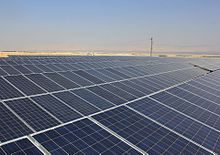Renewable energy in Palestine

Renewable energy in Palestine is a small but significant component of the national energy mix, accounting for 1.4% of energy produced in 2012.[1] Palestine has some of the highest rate of solar water heating in the region,[2] and there are a number of solar power projects. A number of issues confront renewable energy development; a lack of national infrastructure and the limited regulatory framework of the Oslo Accords are both barriers to investment.
Solar power

It has been estimated that solar sources have the potential to account for 13% of energy usage in the Palestinian Territories.
Israeli authorities seized a solar/diesel hybrid electric system from the Palestinian village of
Wind power
It has been estimated that wind energy has the potential to account for 6.6% of energy usage in the Palestinian Territories.[3]
Biomass
About half of the Palestinian population - mainly in the rural areas, refugee camps, and Bedouins of North and South Governorates - are exposed daily to harmful emissions and other health risks from biomass burning that typically takes place in traditional stoves without adequate ventilation. The majority of individuals exposed to enhanced concentrations of pollutants are women and young children.[11]
National policy
The Palestinian Energy Authority (PEA) published a 'General Renewable Energy Strategy' in 2012, aiming for 10% of total domestic energy production and 5% of total energy consumption to come from renewable sources by 2020.[12]
Barriers
There are a number of barriers to development of renewable energy resources in Palestine, including regulatory issues resulting from the Israeli occupation,[13] and this meant the government was unable to achieve its target of 25 megawatts by 2015. However, renewable energy has a large potential to reduce reliance on imported energy and address a number of social issues.[1]
References
- ^ a b Ziad Yamin, Mohammad. "Renewable Energy in Palestine". EcoMENA Echoing Sustainability. Retrieved 6 June 2017.
- ^ "Arab States and Sustainable Energy Capabilities: Brief Profiles on Thirteen Countries' Promising Renewable Energy and Energy Efficiency Markets". Regional Center for Renewable Energy and Energy Efficiency. Retrieved 6 June 2017.
- ^ .
- ^ "Press Release on Results of Household Energy Survey (January 2015)". Palestinian Central Bureau of Statistics (PCBS) - State of Palestine. Retrieved 4 June 2017.
- ^ "No trumpets – solar power for Jericho and its neighbours instead. In the vicinity of the lowest city in the world one of the largest solar power stations in the Middle East produces clean electricity with inverters by KACO new energy". KAKO. Retrieved 31 May 2017.
- .
- ^ McKernan, Bethan. "Israel seizes solar panels donated to Palestinians by Dutch government". Retrieved 5 July 2017.
- ^ "Israel dismantles Palestinian solar project in West Bank". Retrieved 5 July 2017.
- ^ Hass, Amira. "Dutch protest Israeli seizure of Palestinian solar panels they funded in the West Bank". Retrieved 5 July 2017.
- ^ O'Connor, Anne-Marie. "20 minutes from modern Jerusalem, a Palestinian village is stranded in the past". Retrieved 5 July 2017.
- PMID 23694729.
- ^ "A Socio-Economic Analysis of Renewable Energy Usage in Palestine". Heinrich-Böll-Stiftung. Retrieved 6 June 2017.
- .
External links
![]() Media related to Renewable energy in Palestine at Wikimedia Commons
Media related to Renewable energy in Palestine at Wikimedia Commons
